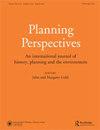Reshaping the frontier landscape: Dongchuan in 18th-century Southwest China
IF 0.9
3区 历史学
0 ARCHITECTURE
引用次数: 0
Abstract
the history of the 1922 World Fair, its planning, built form, and aftermath. For the author, the World Fair became an opportunity to imagine the city and an ideal nation; it became a script for urban development in the modernizing country. The consolidation of Brazilian architecture and engineering was part of this same process. Indeed, the fair celebrated the neo-colonial as the true architecture of Brazil, even when many original colonial baroque structures had been recently demolished. One of the book’s most important contributions is to connect urban planning to racial ideology in thinking on the production of spatial difference and violence against the racialized other and poor. The epilogue makes that case by linking this history with the recent violence against poor racialized communities and the demolition of Vila Autodromo, the favela bulldozed to build the Olympic Village in preparation for the 2016 Summer Olympics, one of the many mega-events that Rio hosted recently. This important, carefully researched book takes on the challenge of thinking about the production of difference, exclusion, and oblivion as part of modernity. And it does it by bringing back to life those condemned by urban reforms and the imagined Brazilian community.重塑边疆景观:18世纪中国西南的东川
1922年世界博览会的历史,它的规划,建筑形式和后果。对作者来说,世博会是一个想象城市和理想国家的机会;它成为这个现代化国家城市发展的脚本。巴西建筑和工程的整合也是这一过程的一部分。事实上,博览会将新殖民主义建筑视为巴西真正的建筑,尽管许多原始的殖民巴洛克式建筑最近已被拆除。这本书最重要的贡献之一是将城市规划与种族意识形态联系起来,思考空间差异的产生以及针对种族化的他者和穷人的暴力行为。结语将这段历史与最近发生的针对贫困种族社区的暴力事件,以及为筹备2016年夏季奥运会(b里约热内卢最近举办的众多大型活动之一)而拆除的贫民窟Vila Autodromo,联系在一起,说明了这一点。这本重要的、经过仔细研究的书挑战了现代性的一部分——差异、排斥和遗忘的产生。它通过让那些被城市改革和想象中的巴西社区所谴责的人重获新生来实现这一点。
本文章由计算机程序翻译,如有差异,请以英文原文为准。
求助全文
约1分钟内获得全文
求助全文
来源期刊

Planning Perspectives
Multiple-
CiteScore
1.50
自引率
12.50%
发文量
85
期刊介绍:
Planning Perspectives is a peer-reviewed international journal of history, planning and the environment, publishing historical and prospective articles on many aspects of plan making and implementation. Subjects covered link the interest of those working in economic, social and political history, historical geography and historical sociology with those in the applied fields of public health, housing construction, architecture and town planning. The Journal has a substantial book review section, covering UK, North American and European literature.
 求助内容:
求助内容: 应助结果提醒方式:
应助结果提醒方式:


